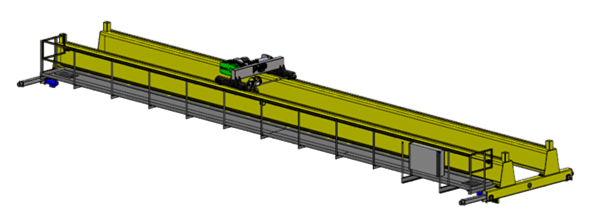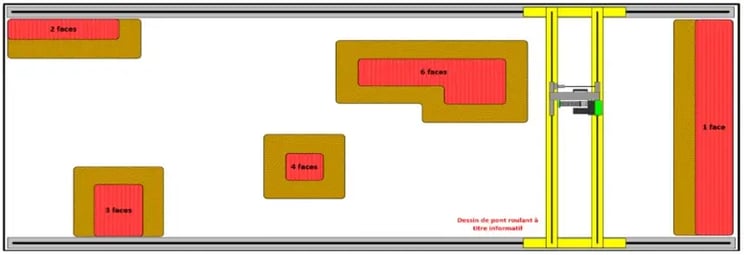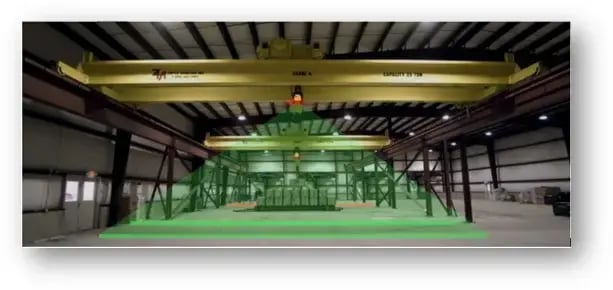-
PRODUCTSreturn
-
SERVICES AND PARTS
-
ABOUT US
The top 10 safety options on an overhead crane
14:46
Safety is a top priority today. To avoid accidents in the workplace, many companies are stepping up their safety measures. Lifting is a sector that is particularly relevant. But what options are available to help you make your lifting operations safer?
Premium Industrial Group, which manufacture between 200 and 250 overhead cranes a year, has installed many of these options over the years. But I’ve found that buyers are often unaware of these solutions. It would be unfortunate if an accident were to occur when a solution was available to prevent it. That’s why we’re presenting the 10 most common safety options for an overhead crane, along with their prices.
After reading this article, you will be familiar with the safety options suited to the most common situations. However, don’t hesitate to share your safety concerns with your representative, as other solutions are available and can even be developed to meet your specific needs.
Note : The prices listed in this article apply to new equipment. For an existing overhead crane, adding these options may require additional modifications, which could result in a higher cost.
1. The spare remote control
What is it?
The remote control is used to control the overhead crane from a distance. Today, the wireless version is the most common. But if it fails, you need to be able to replace it quickly to continue operations.
Wireless control manufacturers have different strategies when supplying this type of system. Some include 2 remotes as standard for the same overhead crane. Others offer just one, but one that can be coupled to several cranes. In all cases, the important thing is to make sure you use a 2nd transmitter safely. To read : How can I ensure safety when using a spare remote control on my overhead crane?

How does this option make your operations safer?
When the main remote control breaks down, the spare one allows you to regain control of your lift and avoid potentially dangerous situations. A load that remains suspended longer than necessary becomes a source of danger for workers.
However, managing the 2nd remote control is also a crucial safety aspect, as some models can be activated at the same time as the main remote control. Imagine the danger of using a 2nd remote control at the same time as the main one!
Pricing
The price of a replacement remote control depends on its configuration, the number of buttons, and the required programming. On average, a standard 8-button transmitter costs around $1,000, but the price can reach up to $10,000 for a custom model equipped with joystick.
2. The anti-collision system
What is it?
This is a system of lasers whose function is to prevent overhead cranes from colliding with each other at full speed. When the system detects the arrival of the other crane, it switches to low speed, and then stops.

How does this option make your operations safer?
Lifting loads can lead to dangerous swaying, source of accidents. The operator must therefore keep it under control at all times. With two overhead cranes on the same track, the risk of collision increases, leading to unexpected sway and accidents. The anti-collision system reduces this risk by slowing or stopping the overhead crane, thus limiting sway and accidents.
Certain precautions must be taken when using this option in lifting operations involving two overhead cranes. We invite you to read our article to learn more : Is tandem lifting dangerous? Master its unexpected dangers!.
Pricing
The most commonly used technology for an anti-collision system between overhead cranes is the laser system. You should expect to pay around $1,000 per laser sensor, or about $2,000 for a system covering two overhead cranes.
3. The end of travel limit switch
What is it?
This is a generally mechanical device designed to prevent the overhead crane or hoist cart from hitting the end stop at full speed. As the overhead crane approaches the end of the runway, a mechanism is activated to reduce speed. The objective is therefore similar to the anti-collision system.
This device is generally standard for overhead crane travel. However, for cart travel, check whether tandem operations (two hoists simultaneously) are planned, as limit switch systems can pose safety problems in this case. For more information, see our article Is tandem lifting dangerous? Master its unexpected dangers!.
How does this option make your operations safer?
The safety benefits are similar to those of the anti-collision system mentioned above, except that the protection is located at the ends of the track rather than between two overhead cranes.
That said, this system also offers other advantages that are less related to safety but still interesting. The end-of-travel limit prevents the motor, and thus the wheels, from continuing to turn when the overhead crane or trolley reaches the end stop. This extends the lifespan of the wheels and rails by reducing wear due to friction. Additionally, it prevents the overhead crane or trolley from hitting the end stops at full speed, thereby reducing the movement of the runway and the risk of damage.
Pricing
The price of a limit switch for the bridge travel is generally included at no extra cost. For trolley travel, however, it is recommended to confirm with your manufacturer. On a single trolley overhead crane, the cost is around $500. In contrast, for a double trolley overhead crane with state sharing for tandem operations, the price can reach up to $3,500, depending on the crane’s electrification type.
4. The rotating beacon
What is it?
The rotating beacon is essentially a light installed on the overhead crane, often orange, which flashes to indicate that the crane is in motion. It’s an optional accessory, although it may be mandatory in certain types of industry, such as foundries.
How does this option make your operations safer?
The flashing light of the moving overhead crane alerts workers that a lifting device is in operation. This reduces the risk of accidents due to inattention.
Pricing
Installing a beacon light or other visual indicator generally costs around $500 per unit.
5. Load display
What is it?
It is an electronic device that displays in real time the load being lifted by the hoist. The weight is clearly visible on a screen, with an accuracy ranging from 2% to 5% of the hoist’s rated capacity. The unit of measurement (lb, kg or tons) and the display position (on the hoist, on the trolley or on the wireless remote) are defined during installation.
How does this option make your operations safer?
Lifting equipment has a capacity limit. Exceeding this limit can lead to collapse, resulting in major damage or injury. That’s why the maximum capacity of the equipment must always be displayed. But the electronic load display increases the level of safety by monitoring the load being lifted in real time. This reduces the risk of lifting parts that are too heavy for the equipment, or mechanically jammed. Note, however, that it is always the operator’s responsibility to know the weight of the part he is lifting (RSST article 248).
Pricing
The price of a load display varies depending on the chosen location. The most common option is to install it directly under the hoist, at a cost of approximately $3,000. It can also be installed on the trolley or elsewhere on the crane structure, with load summation for two hoists, at a cost of approximately $6,000.
6. Lighting
What is it?
This is an LED light system installed directly under the overhead crane or hoist girder to improve ground lighting. This is useful when the overhead crane is partially blocking the light from the building, thus reducing the brightness at ground level. Note that this option is also used for outdoor overhead cranes.

How does this option make your operations safer?
Depending on the operation and configuration of the building, this additional lighting system can help prevent accidents caused by a lack of visibility during certain operations.
Pricing
Whether for indoor or outdoor use, the cost is approximately $2,000 per unit. However, the price may vary depending on the desired features, such as adding a light sensor or a dedicated button on the remote control.
7. The maintenance bridge
What is it?
These are platforms with railings, usually attached to a double girder overhead crane. They can take a variety of shapes and be placed in different locations, with different types of flooring. It provides access to lifting equipment for maintenance of certain components. Accessories such as fall arrest systems or engine access hatches can also be added.

How does this option make your operations safer?
The walkway facilitates maintenance in complete safety, offering easy access along the entire length of the overhead crane. Once the overhead crane has been disconnected from the power supply and padlocked, maintenance can be carried out in complete safety, without the risk of electrical accidents or hazards associated with lifting platforms, such as collisions with moving vehicles.
Pricing
The design and cost of a walkway are influenced by several factors, including the span of the overhead crane, the addition of stairs, the required clearance in front of control panels, and the inclusion of a lifeline or motor access hatches. For a standard 60 ft walkway, the price generally ranges between $20,000 and $25,000.
8. Temporary end stop
What is it?
A temporary end stop is an easy-to-install, easy-to-remove mechanical device on a runway track. It is used to stop an overhead crane, enabling it to be isolated for maintenance, even if other lifting devices are on the same runway. It can also prevent an overhead crane from reaching an area where maintenance work is being carried out on building mechanics (garage doors, overhead lights, ventilation, etc.).

How does this option make your operations safer?
When a worker is performing maintenance on an overhead crane, the presence of other cranes in the same track can create a risk of accident. Another piece of equipment could collide with the one being serviced, endangering safety. The temporary bumper isolates the overhead crane undergoing maintenance, preventing it from colliding with other cranes. Similarly, when maintenance work is being carried out on garage doors or other building equipment located close to the runway tracks, temporary bumpers protect workers from overhead crane movements.
Pricing
The cost of a pair of temporary bumpers is $1,875 CAD.
9. The zoning system
What is it?
It’s a solution made up of sensors and controllers that can be used to program no-go zones for the overhead crane. When the overhead crane approaches these zones, it will slow down and stop at the edge of the zone. This option is particularly useful when an overhead crane is installed in an area with several critical machines or frequently moving personnel.
How does this option make your operations safer?
Even if overhead crane operators are trained, mistakes can still occur. This system blocks the movement of a load towards an area where workers or machines are present, thus preventing collisions, damage and injury.
Pricing
The cost of a zoning system depends on the number of sides to be protected and the intended use. If the sensors are placed in the middle of the runway with heavy traffic, more robust sensors such as magnetic or laser types are preferred. Conversely, if the protected area is located at the end of the runway with little traffic, more economical limit switches, such as cross-type switches, may be used. As a guideline, a two-side system for light use costs around $3,500, while a four-side system for heavy-duty use can reach up to $8,000.
10. Security lights
What is it?
Not to be confused with the rotating beacon or LED lighting, the security light is a light directed at the ground to indicate overhead crane movement. It can be installed on the frame of the overhead crane or on the hoist. When installed on the overhead crane, it is static and indicates crane movement on the ground. When installed on the hoist, it tracks cart movements. There are several types available: projectors, laser in straight or grid pattern, etc.

How does this option make your operations safer?
This option takes safety to another level, providing a visual indicator not only of the device’s movement, but also of its exact location. Its use is often of interest on pedestrian walkways. However, some operators do not appreciate this option, which can be considered blinding.
Pricing
Several configurations are possible for safety lights, including lines, squares, or dots projected on the floor. The technology can also vary, ranging from laser to LED lighting. Installation height and the surrounding environment are also factors to consider. As a guideline, for an overhead crane with two laser lines, the cost is around $8,000, while a single floor dot with LED lighting costs about $2,500.
In summary
OPTION
DANGER AVOIDED
SPARE TRANSMITTER
Suspended load
ANTI-COLLISION SYSTEM
Load sway
END OF TRAVEL LIMIT SWITCH
Load sway
ROTATING BEACON
Collision with a load
LOAD DISPLAY
Overload
LIGHTING
Lack of visibility
MAINTENANCE BRIDGE
Lack of access to components
TEMPORARY BUMPERS
Overhead crane collision
ZONING SYSTEM
Collision with a load
SECURITY LIGHTS
Collision with a load
Overhead crane operator training: not optionalIn Quebec, an overhead crane may only be operated by an operator who has received theoretical and practical training from a qualified instructor, as required by section 254.1 of the RROHS. This training course, adapted to the workplace, covers equipment, slinging techniques, inspections, and safety regulations. Learn more about the training obligations for overhead crane operators. |
Choose the right options for you
Now that you know about these security options, you have more information in your pocket. You can analyze your operations with these solutions in mind and identify the options that will increase security in your context.
It is important to note, however, that several of these options are more advantageous to integrate at the time of purchasing your crane. Once the equipment is installed, adding them can result in higher installation costs on site.
And if you haven’t found a solution to your security issue after reading this? These 10 options are just an overview. To determine the right solution, have your needs analyzed by a specialist. The article Need an overhead crane: Where to start? will help you prepare for this important step.
Technical representative at Premium Industrial Group inc.
Learning Center
Whether you're an expert or know nothing about cranes, you'll find everything you need to know HERE.








